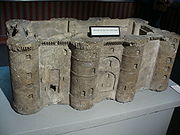
Pierre-François Palloy
Encyclopedia

Bastille
The Bastille was a fortress in Paris, known formally as the Bastille Saint-Antoine. It played an important role in the internal conflicts of France and for most of its history was used as a state prison by the kings of France. The Bastille was built in response to the English threat to the city of...
.
Biography
Palloy was born in 1755 in Paris. He left school at the age of fifteen to join the French Royal ArmyFrench Royal Army (1652–1830)
The French Royal Army served the Bourbon kings beginning with Louis XIV and ending with Charles X with an interlude from 1792 until 1814, during the French Revolution and the reign of the Emperor Napoleon. After a second, brief interlude when Napoleon returned from exile in 1815, the Royal Army...
. On leaving this career he married the daughter of a building contractor and joined the trade himself, eventually taking over his new family's business. By 1789 he had made the company one of the largest building firms in Paris, employing 400 workers.
Demolition of the Bastille
When the Bastille fellStorming of the Bastille
The storming of the Bastille occurred in Paris on the morning of 14 July 1789. The medieval fortress and prison in Paris known as the Bastille represented royal authority in the centre of Paris. While the prison only contained seven inmates at the time of its storming, its fall was the flashpoint...
on 14 July 1789 there was some debate as to what should replace it, or indeed if it should remain as a monument to the past. However, Palloy knew exactly what he wanted to do and by that evening had begun the process of dismantling the structure; he secured the contract to demolish the building two days later. Most of the building was removed over the subsequent months by approximately 1,000 workers. The dimension stone
Dimension stone
Dimension stone is natural stone or rock that has been selected and fabricated to specific sizes or shapes. Color, texture and pattern, and surface finish of the stone are also normal requirements...
s were reused for the construction of the Pont de la Concorde
Pont de la Concorde (Paris)
The Pont de la Concorde is an arch bridge across the River Seine in Paris connecting the Quai des Tuileries at the Place de la Concorde and the Quai d'Orsay...
.
Although Palloy did not receive the official payment for several years, he knew how to profit from the possession of such an iconic structure in the meantime. Staff conducted tours, for a fee, to show the public around the basements and dungeons with skeletons as props. Palloy labelled himself a patriot
Patriotism
Patriotism is a devotion to one's country, excluding differences caused by the dependencies of the term's meaning upon context, geography and philosophy...
and emphasised the symbolism of the Bastille, writing speeches, painting pictures, and even arranging celebratory festivals and theatrical reconstructions of the day the Bastille fell. He sold other parts as souvenirs including replica Bastilles made from the
stones of the building itself. He even sent examples of these miniatures to each of the 83 departments asking only to be reimbursed for transport and postage.
Later life
In early 1794 Palloy was held in prison on charges of embezzlementEmbezzlement
Embezzlement is the act of dishonestly appropriating or secreting assets by one or more individuals to whom such assets have been entrusted....
and of being a Hébertist
Hébertists
The Hébertists were an ultra-revolutionary political faction associated with the populist journalist Jacques Hébert. They came to power during the Reign of Terror and played a significant role in the French Revolution....
but was released after two months. In 1814 he was awarded the Décoration du Lys
Décoration du Lys
The Décoration du Lys was a medal created by the Bourbon Restoration. -Background:From the end of 1813, Napoleon's armies were fighting on their own soil, culminating in the Six Days Campaign. Napoleon ended his reign with a series of Pyrrhic victories which could not save the Empire, and he...
.

